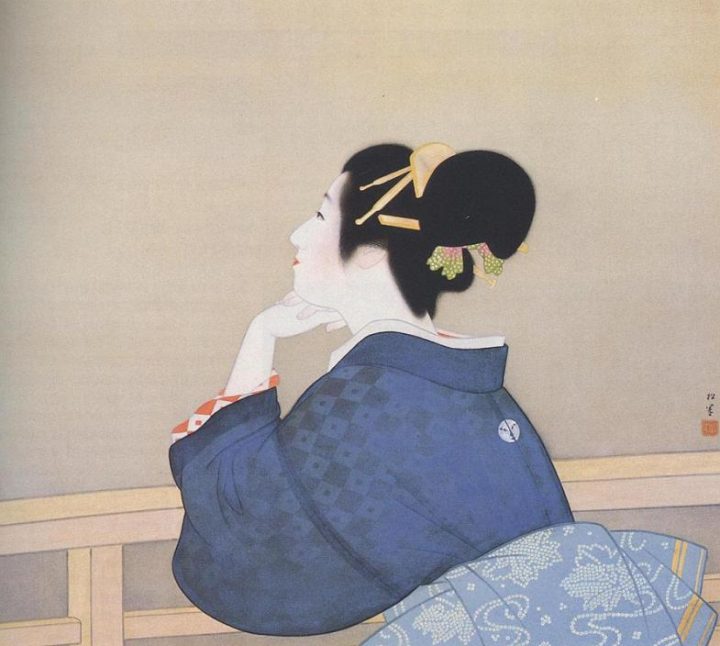The most known among women painters in the Japanese art is Uemura Shōen of which we comment some works below.
Uemura Shōen, whose real name was Uemura Tsune – the pseudonym was given by her master in recognition of her talent -, was born on April 23, 1875 in the province of Kyoto and died on August 27, 1949 in the prefecture of Nara. She was the second daughter of a tea merchant and devoted herself to studying different styles of Japanese traditional painting, notably those according to the Kanō and Sesshū schools. Uemura was awarded local and national prizes and focused on the task of showing her pieces for the governmental Bunten exhibition. It happened that the duke of Connaught bought her painting entitled “The Beauty of Four Seasons” and therefore she took off at international level.
During the Second World War, Uemura took a trip by invitation of the Japanese Government to war zone of China for the twofold purpose of campaigning and reassuring people. Note that she confronted in old age the latter enterprise and obtained a number of prestigious awards in the cultural sphere.
Even Uemura, as it was with Yokoyama, followed the Nihonga current, preferentially joining the traditional bijinga genre concerned with portraiture of gorgeous women. The paintings we are examining belong to this genre.
Making a Wish for a Long Life on Chrysanthemums by Uemura Shōen, 1939, Tokyo Fuji Art Museum
The first painting is an intimist picture shooting a scene of spiritual communication with nature. The torso of the female lady person is slightly bent down, while the head is laterally tilted and gently leaned over to the chrysanthemums positioned at the opposite end of the painting. The silhouette is sharp and solid colored, except for the shaded rendering of, and finely decorated, silk dress. The painted version of the hairstyle, that seems almost a gentle halo surrounding the pale face, is so accurate that even the individual hair is perceivable. That careful coiffure is a boxlike shimada, the eyebrows and mouth respectively seem fuzzy wings and flower petal, whereas the gaze’s overflowing with tenderness.
Woman Waiting for the Moon to Rise by Uemura Shōen, 1944, Adachi Museum of Art
In the second painting, the young lady standing on a balcony is portrayed in the very rising-moon moment. The ambient light blue matches the color shading of the kimono which shows the traditional fantasies of the Japan women’s clothes. An unusual particularity is represented by the transparency of the outer kimono through which a fabric, printed with a red-white color pattern, is visible. The ribbon with pink and green pastel shades applies rather well to the youthfulness of the subject, maybe appropriate to the shimada hairstyle of momoware type. The finely textured hair gently hides her forehead and ear. The subject takes a dreamy look.
Large Snowflakes by Uemura Shōen, 1944, Adachi Museum of Art
Large snowflakes are dancing against a gilded sky like silk. The unexpected snowfall is overtaking two ladies which appear almost laughing of the ongoing little nuisance while they are battening down. One of them, specifically the following lady which, maybe, is the younger one, is wearing a blue-violet cape for head, mouth and ears to be covered and holds her hands fully got into the sleeves of her dress. The other lady is simply putting one hand under a sleeve while the other hand is lifting up her vividly colored kimono to go faster. The graceful pair of umbrellas – one of them displaying the outer side, the other a finely structured inner side – overall look almost weightless and refer to a sort of poetical dialogue. The picture turns out to be the snapshot of an instant and, as such, cannot but sound like a photograph. It is more akin to the work entitled “Che freddo!” (It’s so cold!) by the Italian painter Giuseppe De Nittis, an author who can be included in the current of Japonism because he knew Japanese art and was influenced by it. In both cases the spontaneity of a moment of daily life is portrayed; in Uemura there is also, however, the will to deliver to the memory some tender facets of her own world. To the time of this painting, that is at the end of the war, that world was going to be overwhelmed for evermore.
Che freddo!, De Nittis, 1870, Palazzo della Marra, Barletta (Italy)
Copyright © arteingiappone – All rights reserved
The pictures are from: https://www.google.com/culturalinstitute/asset-viewer/making-a-wish-for-a-long-life-on-chrysanthemums/MwGZ0DzqEIoUzw?hl=it&projectId=art-project
http://www.lingnanart.com/2013-J-master/J-master-shoen-009.htm
https://www.google.com/culturalinstitute/asset-viewer/large-snowflakes/6gFlCqy4-BIjJA?hl=it&projectId=art-project
http://freemaninrealworld.altervista.org/un-italiano-a-parigi-giuseppe-de-nittis/



